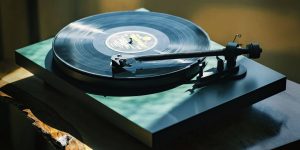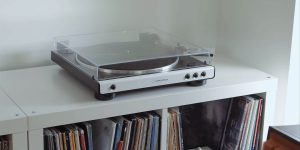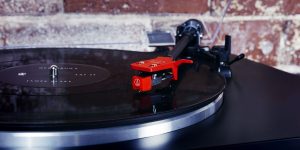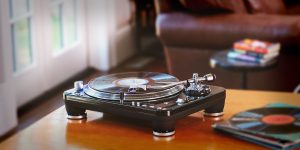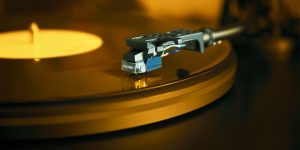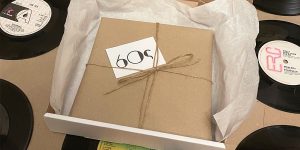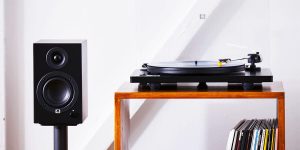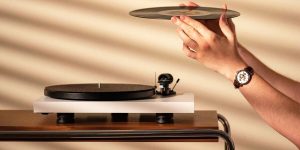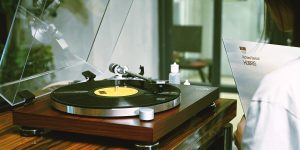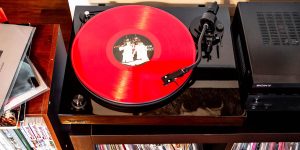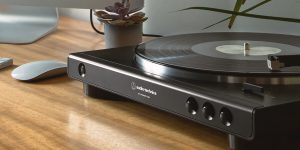For those passionate about vinyl, the allure of a well-crafted turntable is undeniable. Positioned in a sweet spot between entry-level models and ultra-premium units, the best turntables under $ 1,000 serve as a testament to both performance and elegance. These players encapsulate rich, intricate sound profiles, often paired with functional and aesthetically pleasing designs.
From powerful direct-drive units to intricately crafted belt-driven systems, the choices in this price bracket truly cover a wide spectrum of tastes and needs. I’ve written this article to lead you through these options, ensuring you discover the turntable that matches both your sonic aspirations and visual desires.
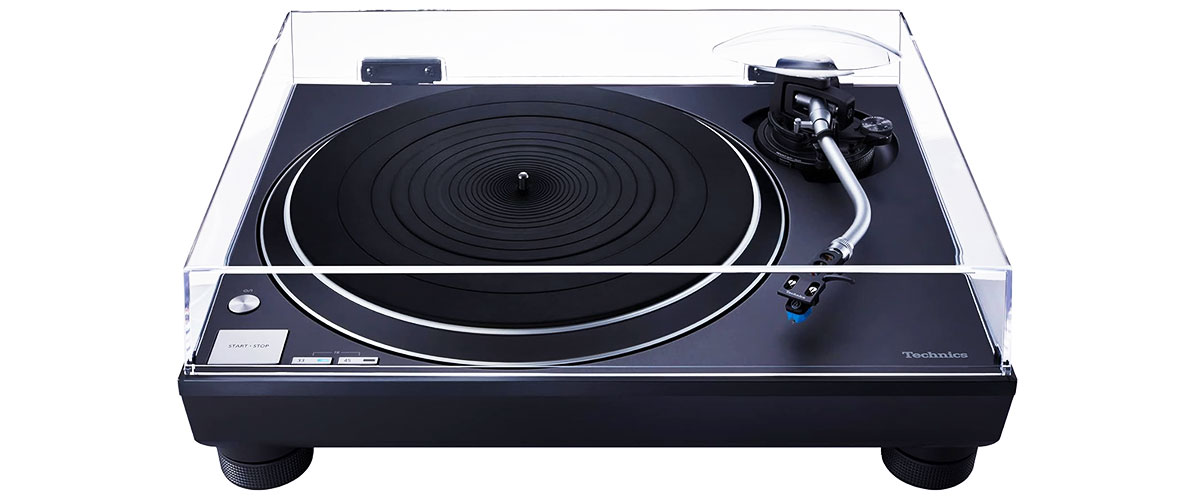
Turntables under $1000 comparison table
| Name | Drive type | Operation type | Speeds | Phono Pre-Amp | Bluetooth | Review |
|---|---|---|---|---|---|---|
| Technics SL-100C best overall | direct | semi-automatic | 33 1/3, 45, 78 RPM | yes | no | Review |
| Pro-Ject Debut Carbon EVO also great | belt | manual | 33 1/3, 45, 78 RPM | no | no | Review |
| Rega Planar 2 | belt | manual | 33 1/3, 45, 78 RPM | no | no | Review |
What to look for when choosing a record player under $1,000
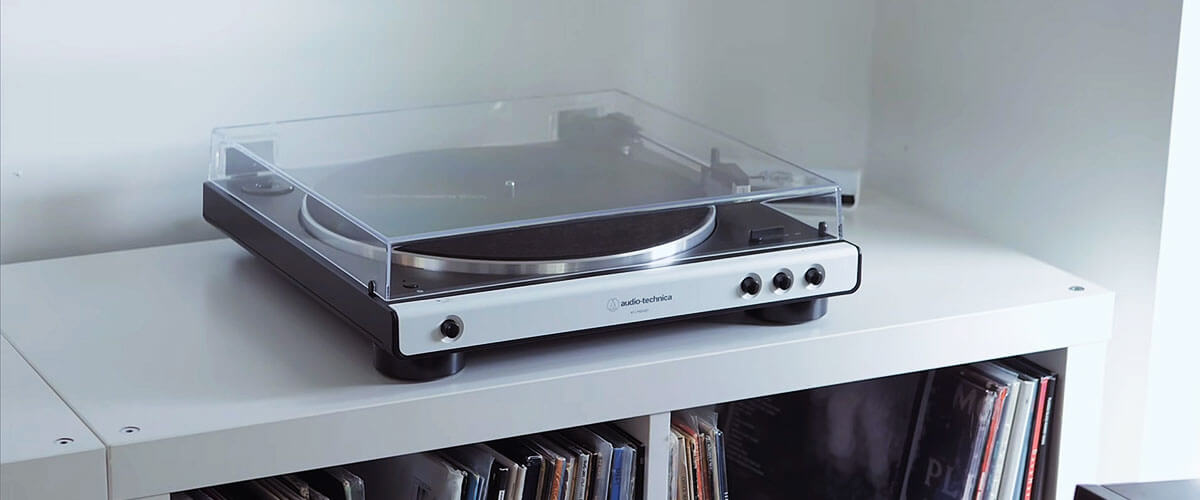
Choosing the right turntable involves more than just price. In this section, I’ll break down essential features and nuances you should consider. From drive types to cartridge quality, we’ll delve into what truly matters in a sub-$1,000 record player.
Drive type: direct vs. belt-driven
One of the primary distinctions in turntables is the drive type: direct or belt-driven. Each offers a unique listening experience and comes with its own set of advantages.
Direct-drive turntables have the motor situated directly beneath the platter. This results in a quick start-up speed, often preferred by DJs for scratching and mixing. The direct connection ensures a consistent rotation speed, leading to a stable playback. However, it might introduce minor vibrations, which, for the purists, can affect the sound quality.
Belt-driven turntables, on the other hand, use an elastic belt to connect the motor to the platter. This setup naturally isolates the platter from motor vibrations, often yielding a cleaner sound. The trade-off is a slightly slower start-up speed and the need for occasional belt replacements.
In the end, your choice depends on personal preference. DJs might lean towards direct-drive for its responsiveness, while audiophiles may appreciate the purity of sound from a belt-driven system.
Manual vs. automatic operation
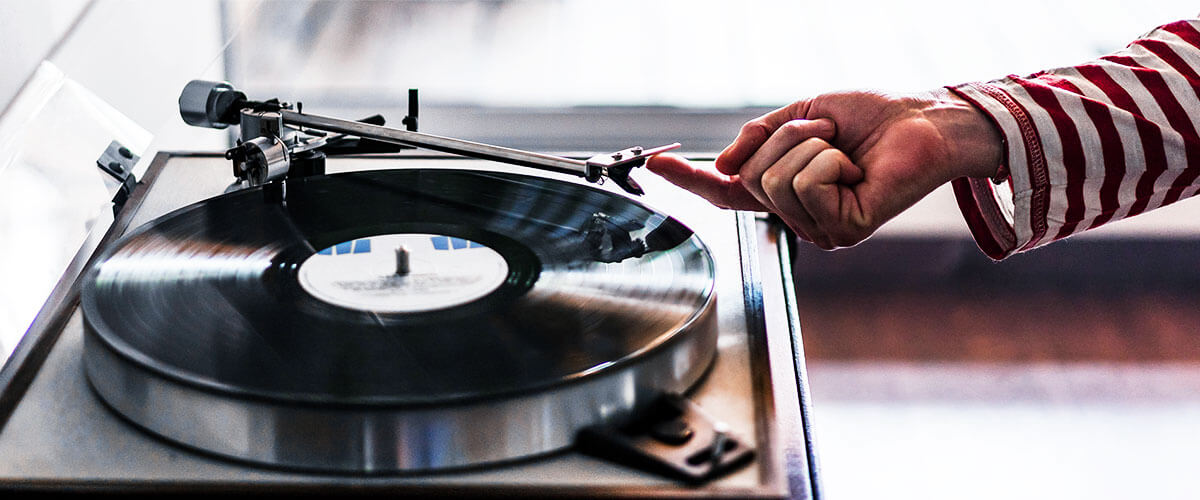
The operation mode of a turntable, whether manual or automatic, significantly influences the user experience, and choosing between them depends on personal needs and the desired level of interaction.
Manual turntables require you to physically lift the tonearm and place the needle on the record, as well as lift it at the end of the playback. This hands-on approach is often favored by enthusiasts, as it allows for a more intimate connection with the music. Additionally, manual operation tends to be a common feature in many audiophile turntable designs, as it minimizes the number of components that could potentially introduce noise or vibrations.
Automatic turntables, in contrast, automate the process of needle placement and return. This convenience is perfect for those who prefer a more straightforward, hassle-free listening experience. Yes, the additional mechanics in such systems can indeed affect the clarity of the sound, but despite this, some fully automatic models provide quite good sound quality.
To sum up, whether you enjoy the ritual of manual operation or the ease of an automatic system, there are turntables in both categories to suit your needs.
Cartridge type and quality
The cartridge is a critical component of any turntable, housing the stylus that reads the record’s grooves. Its type and quality play a huge role in the audio output.
Moving Magnet (MM) cartridges are more common and user-friendly, as they allow for easy stylus replacement. They tend to be more affordable and are known for their balanced sound profile and wide compatibility with phono preamps.
Moving Coil (MC) cartridges, on the other hand, are often found in higher-end turntables and favored by audiophiles for their nuanced sound reproduction. They generally provide a more detailed audio experience but come at a higher price point and require a specific type of phono preamp or a step-up transformer.
No matter which cartridge type you lean towards, its overall quality, including parts like the stylus and cantilever, is crucial. I’ve often found that investing in a premium cartridge or pondering an upgrade can truly transform your listening sessions. Many sub-$1,000 turntables come equipped with either MM or MC cartridges that genuinely shine. My advice? Always keep an eye on cartridge specs and stay receptive to upgrades – it’s a surefire way to keep your vinyl performance vibrant and immersive.
Phono preamp integration
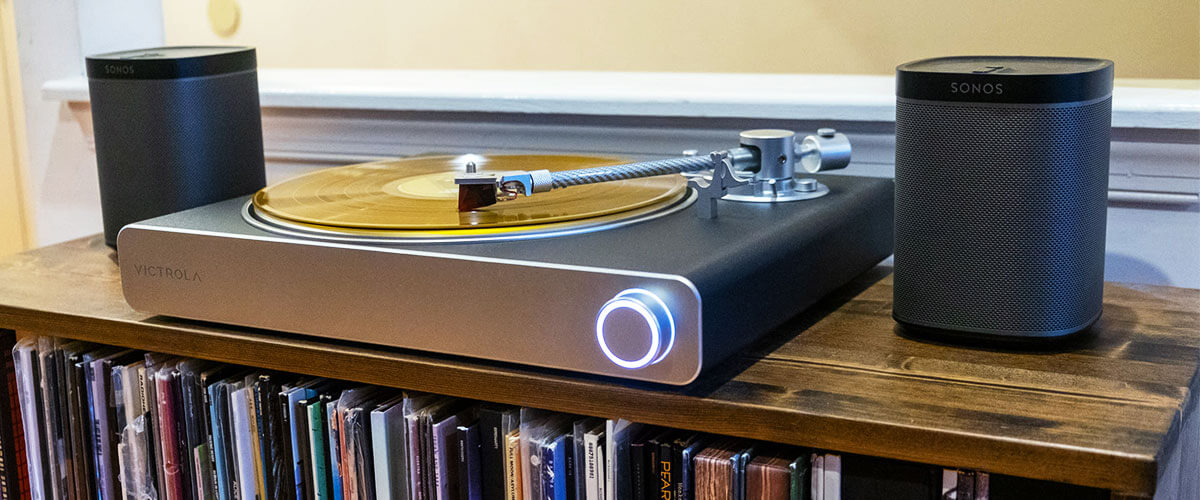
A phono preamp amplifies the low-level signal from the cartridge to a level your audio system can work with. When choosing a TT, you’ll encounter both built-in and external phono stage options.
Turntables with integrated preamps offer a convenient, all-in-one solution, making setup and connectivity a breeze, especially for newcomers or those looking to minimize additional components. However, the quality of built-in preamps can vary, and in some cases, it might not meet the standards of discerning listeners.
On the flip side, an external phono stage can provide a more tailored audio experience. Opting for a separate preamp allows you the freedom to choose a device that aligns with your audio preferences and potentially upgrade over time. While this route may demand a bit more research and investment, the payoff in sound quality and customization can be well worth it.
Build quality and materials
A well-constructed turntable acts as a shield, defending your music from unwanted interference and ensuring pure, undistorted sound.
Dense plinths and platters are more than aesthetic choices; they serve a functional purpose. Dense materials are inherently better at absorbing and dispersing vibrations. This means that any external forces, from footfalls to other electronics, are less likely to disrupt your vinyl’s playback. A heavier platter, for instance, offers more inertia, ensuring consistent speed and reducing the impact of vibrations.
Dampening features also come into play, often in the form of special materials or designs within the turntable’s construction. These features help absorb micro-vibrations, ensuring that what you hear is the music in its purest form, not the noise of the surrounding environment.
Lastly, isolation feet are unsung heroes in a turntable’s design. Their primary role is to decouple the TT from its resting surface, further minimizing the risk of external vibrations reaching the sensitive stylus and affecting playback.
In essence, investing in a machine with solid construction and attention to these details ensures that your records are always heard as the artist intended, free from the distortions and interruptions of the outside world.
Best turntables under $1,000 reviews
Technics SL-100C – best overall

Technics, a titan in the audio world, graces us with the SL-100C. From the moment I unboxed it, I could immediately appreciate its sleek, minimalist design. It exudes a sense of elegance, and I couldn’t help but be impressed by its weight, suggesting a solid build.
Assembling the unit was straightforward, and I appreciated the adjustable tonearm height, which offers users plenty of room to fine-tune and optimize tracking for an enhanced listening experience. Spinning a mix of jazz, rock, and electronic albums, I was particularly drawn to Miles Davis’ “Kind of Blue”. The details captured by the high-sensitivity aluminum S-shape tonearm were exquisite. Every trumpet note, every subtle brush of the snare, was relayed with pristine clarity.
The coreless direct drive motor ensures a smooth playback experience. Coupled with the pre-installed Audio-Technica cartridge, the depth and warmth of the music were brought to life beautifully. However, I did notice that the needle lingers at the end of records slightly longer than expected. For me, this is a double-edged sword: on one side, it’s a protective measure, but on the other, it can be a waiting game
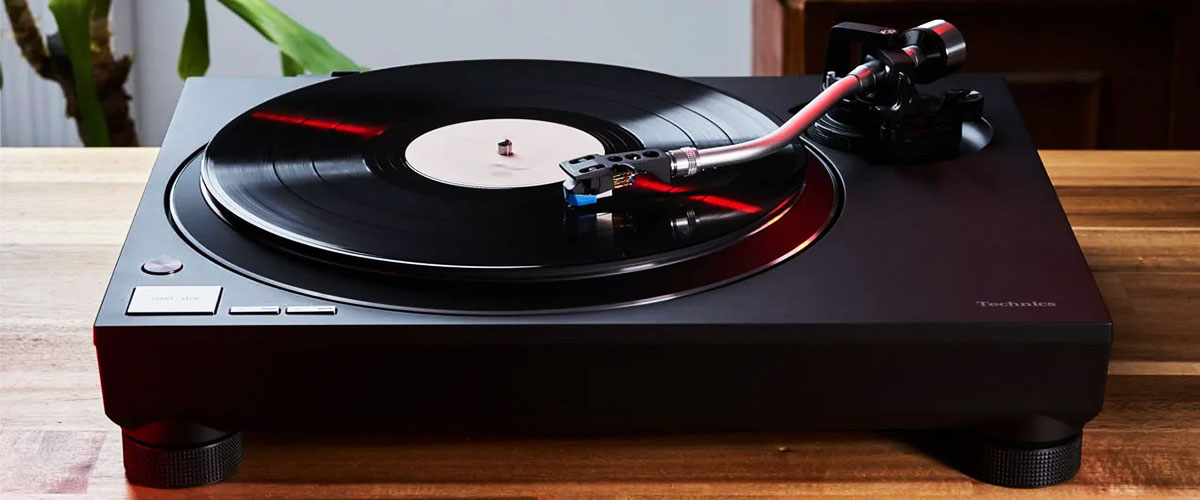
Comparing the SL-100C to other contenders in its price range, such as the Pro-Ject Debut Carbon EVO or the Rega Planar 2, it becomes evident why this turntable takes the lead. While the Debut Carbon EVO boasts an array of vibrant colors and the Planar 2 impresses with its focused design for sound isolation, the SL-100C strikes the perfect chord with its reliable performance and sleek, user-friendly design. It confidently positions itself as a great $1,000 turntable, ensuring a captivating auditory journey from start to finish.
In conclusion, the SL-100C isn’t just another turntable, it’s an experience! It delicately bridges performance and aesthetics, making each vinyl session feel like an intimate concert. Whether it’s your first step into the vinyl or you’re looking to upgrade, this turntable has the potential to redefine your musical moments.
Key specs
- Drive type: direct.
- Operation type: semi-automatic.
- Speeds, RPM: 33 1/3, 45, 78.
- Phono Pre-Amp: yes.
- Bluetooth : no.
- USB: no.
- Aux in.: no.
Pros
- Built to last.
- Advanced motor – ensures stable rotation and robust performance.
- Sensitive tonearm – provides precise tracking and minimal distortion.
- Comes pre-installed with an Audio-Technica cartridge.
- Straightforward setup process with minimal tweaking required.
Cons
- The needle sits at the end of the record for an extended period, which might be inconvenient for some users.
Pro-Ject Debut Carbon EVO – also great
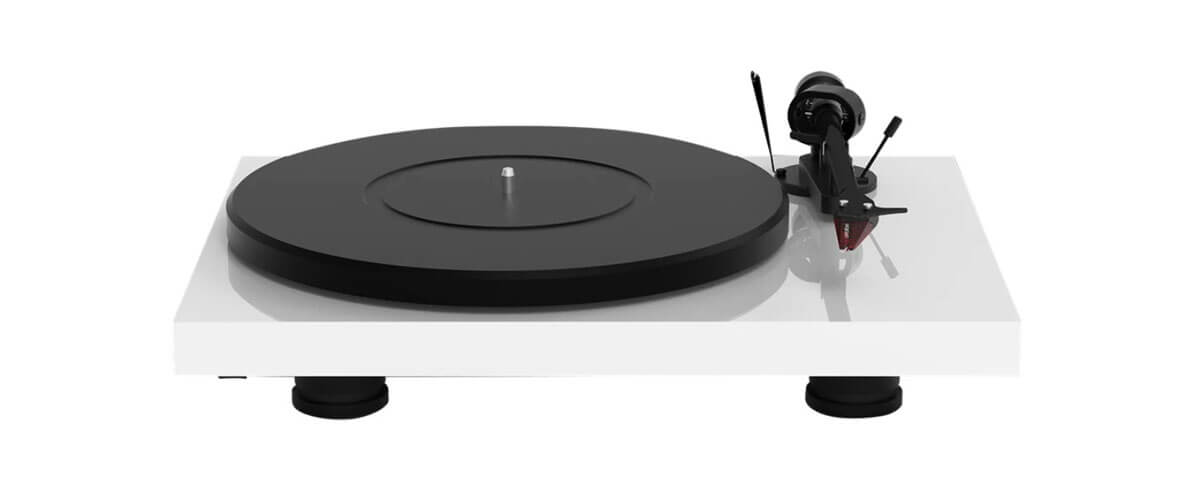
Pro-Ject, renowned for its ability to blend aesthetic appeal with stellar audio performance, truly shines with the Debut Carbon EVO. This turntable is a dream come true for keen listeners seeking a harmonious balance between affordability and high-quality sound.
Sporting an 8.6″ carbon fiber tonearm and a substantial 1.7kg steel platter, the Debut Carbon EVO guarantees a stable, resonance-free playback experience. The tonearm glides smoothly across the vinyl, thanks to its low-friction sapphire bearings, ensuring precise tracking and authentic audio reproduction. Pre-mounted with a precision-aligned Sumiko Rainier phono cartridge, the player is ready to play right out of the box.
One feature I particularly enjoyed was the electronic speed selection, accommodating 33, 45, and even 78 RPM records. This adaptability is a godsend, especially when I’m in the mood to shuffle between my classic rock records and some old-school jazz.
The turntable’s design is nothing short of eye-catching, available in a spectrum of colors that can fit any aesthetic preference. It’s clear that Pro-Ject doesn’t just want you to hear your music; they want the turntable to be a centerpiece in your space.
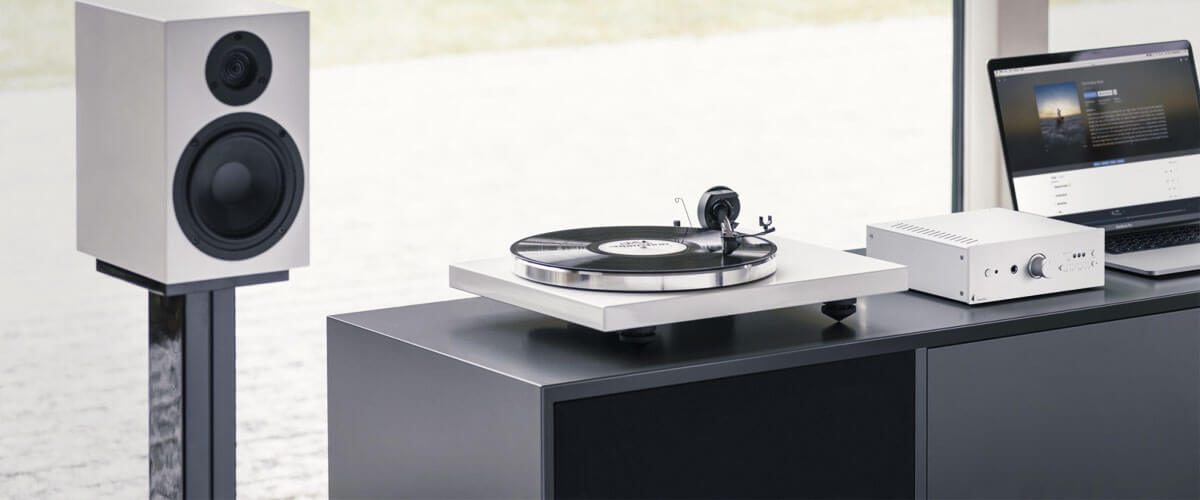
That being said, this unit isn’t without its quirks. The cover could use a bit of an upgrade for better stability and to safeguard the finish on the plinth. Moreover, dialing in the tonearm and needle does take a moment, but trust me, the sonic payoff is entirely worth the attention to detail.
The Debut Carbon EVO, with its distinct allure, finds a sweet spot between affordability and high performance, complemented by user-friendly features. While it may lack specific attributes like the Technics’ auto-lifter or the Rega’s isolated design, it more than compensates with its harmonious blend of value and audio fidelity.
This model also confidently claims its position as the best turntable under $1,000 in terms of price-quality ratio, presenting an accessible path to superior sound quality.
Key specs
- Drive type: belt.
- Operation type: manual.
- Speeds, RPM: 33 1/3, 45, 78.
- Phono Pre-Amp: no.
- Bluetooth : no.
- USB: no.
- Aux in.: no.
Pros
- Low noise level.
- High-quality tonearm provides reduced resonance and enhanced sound quality.
- Super convenient electronic speed selection feature.
- Comes with a factory-mounted and precision-aligned cartridge.
- Elegant design with various color options.
Cons
- The setup process, particularly the vertical tracking force adjustment, can be a bit time-consuming.
- The dust cover design and its attachment to the hinges are potential areas of improvement.
Rega Planar 2
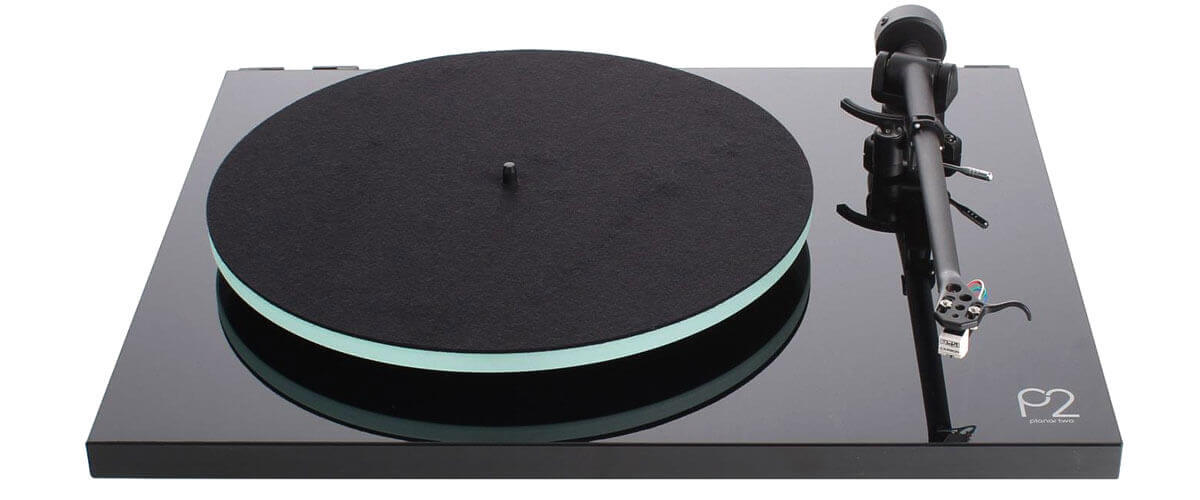
Delving into the Rega Planar 2, it’s immediately apparent that this turntable is a blend of meticulous design and thoughtful engineering. Renowned for its dedication to quality audio equipment, Rega doesn’t disappoint with this particular model.
The first thing that stands out is the turntable’s solid construction. It’s evident that every component, from the tonearm to the platter, has been crafted with precision. The Planar 2 features a sleek, minimalist design, allowing it to integrate into any living space seamlessly.
In terms of performance, the TT is a delight. It comes equipped with the Rega Carbon cartridge, which, after a decent break-in period, reveals its true potential. Also, the isolated build plays a significant role in the player’s audio clarity. By ensuring that vibrations and interference are kept at bay, it provides a pure listening experience.
I love that the player handled every music genre I threw at it with such finesse, truly capturing the essence of each song. For me, listening to it was like re-discovering my favorite albums all over again. The details were crisp, and the bass had a warm depth to it. I was particularly taken by how it brought out the live energy of the tracks, making me feel as if I were at a private concert.
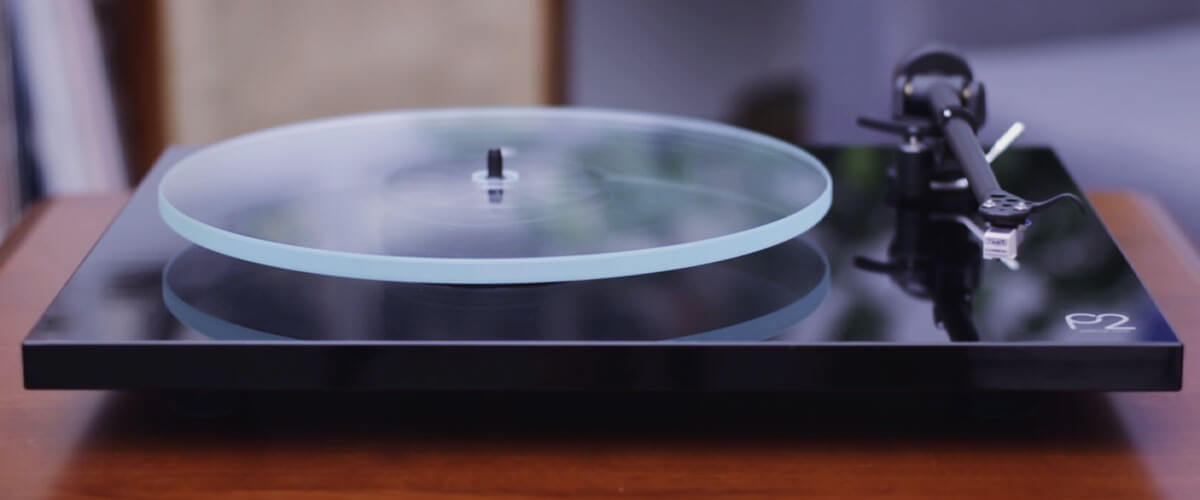
However, it’s not without nuances. The balancing of the tonearm might pose a slight challenge, especially for newcomers. Additionally, there’s a slight inconsistency with the mat on the glass platter, making it appear off-balance during spins. Yet, once these initial setup intricacies are addressed, the Planar 2 proves to be utterly entrancing.
To sum up, the Rega Planar 2 secures its position as the best record player under $1,000 in terms of providing a pure, undisturbed audio experience backed by a solid build. For enthusiasts who prioritize sound quality, the Planar 2 is a choice that promises and delivers audio excellence.
Key specs
- Drive type: belt.
- Operation type: manual.
- Speeds, RPM: 33 1/3, 45.
- Phono Pre-Amp: no.
- Bluetooth: no.
- USB: no.
- Aux in.: no.
Pros
- Effective vibration control – a separated motor reduces vibration transfer, ensuring cleaner sound.
- High-quality construction – from the smooth tonearm bearings to the balanced platter.
- The Rega Carbon cartridge receives praise for its sound quality, especially after a break-in period.
Cons
- Issues with the platter mat’s roundness.
- Balancing the tonearm and dealing with the preset anti-skate setting can be challenging for some.
Audio-Technica AT-LP7
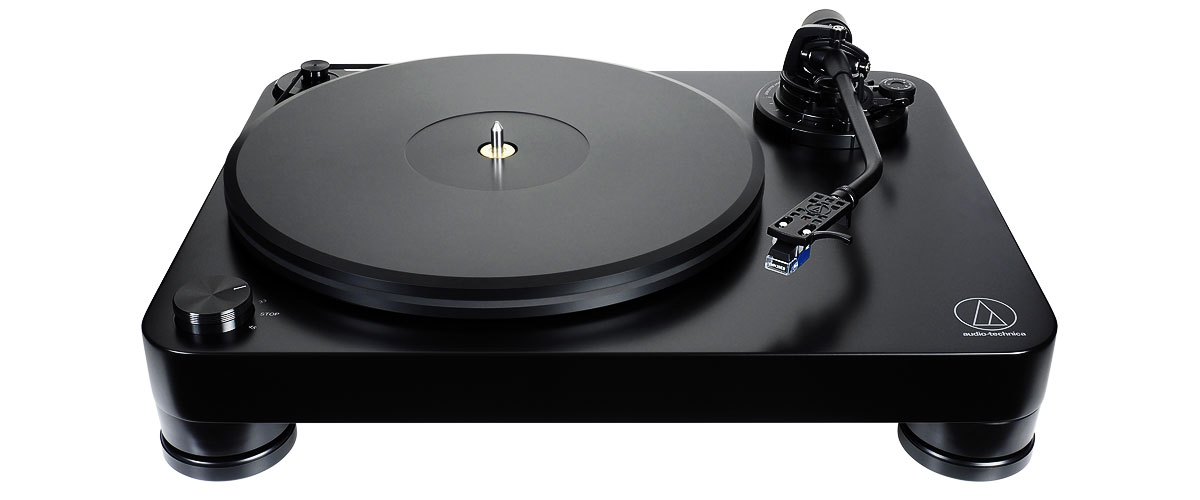
Audio-Technica brings the AT-LP7, a fully manual, belt-drive turntable that has garnered attention in the audio community. Before I started testing this unit, I noticed its solid construction and thoughtful design, especially the solid MDF chassis and the polyoxymethylene anti-resonance disk. The intention behind its construction is clear: to provide a reliable audio performance.
With two-speed belt-drive operation, the AT-LP7 caters to both 33-1/3 and 45 RPM records. I’m particularly impressed by its speed-sensor system – it’s like having a vigilant co-pilot that keeps your vinyl playing perfectly. The J-shaped tonearm, furnished with a metallic gimbal suspension system, not only pays homage to designs from the 60s and 70s but also offers reduced tracking errors.
The inclusion of an onboard phono stage that supports both MM and MC cartridges adds to the convenience and versatility of this model, positioning it as a strong option in the sub-1000 dollar turntable market.
In my listening sessions across different musical genres, the AT-LP7 delivered a respectable audio performance. The bass was present, although it might not satisfy those seeking a more dominant low-end response. The clarity in intricate musical compositions was decent, but there were moments where it could have been sharper.
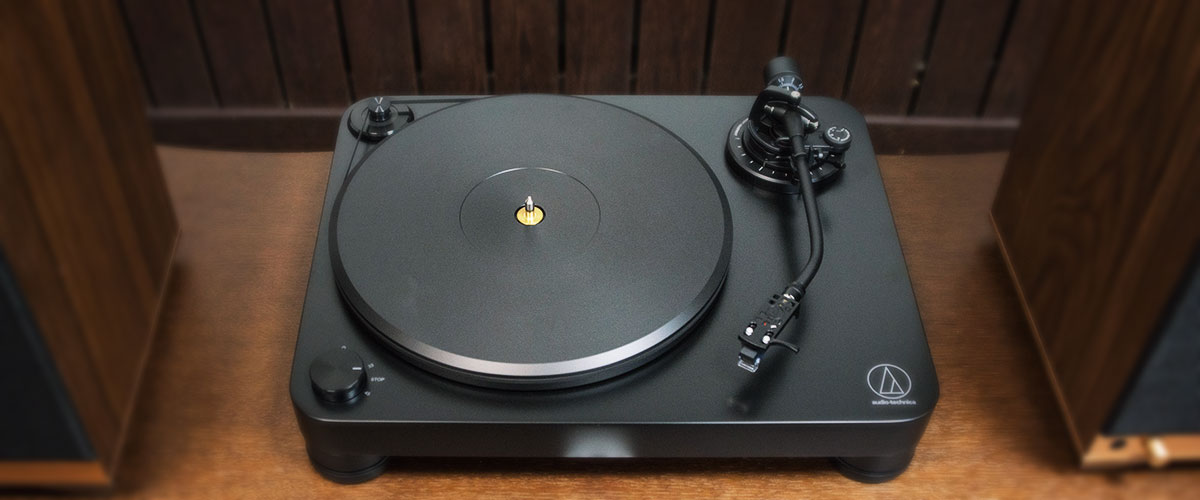
The player’s design is simple, hosting only the essential components beneath the dust cover, which could be seen as a positive or a negative depending on personal preference.
Downsides? The switches located at the back of the unit might pose accessibility issues for some users. Additionally, balancing the tonearm may require some patience, particularly for newcomers. While these aspects could be improved, they don’t severely impact the AT-LP7’s overall performance.
In wrapping up, the Audio-Technica AT-LP7 stands as a reliable choice within the category of top turntables under 1,000 dollars. Its robust build, coupled with thoughtful features, contributes to a solid audio performance.
Key specs
- Drive type: belt.
- Operation type: manual.
- Speeds, RPM: 33 1/3, 45.
- Phono Pre-Amp: yes.
- Bluetooth: no.
- USB: no.
- Aux input: no.
Pros
- Solid construction.
- Speed-sensor system – ensures accurate platter speed.
- The cartridge allows for easy stylus replacement, offering flexibility and ease of maintenance.
- High-quality tonearm – provides accurate tracking and reduced distortion.
- Decent onboard phono stage.
Cons
- Difficult to use switches.
- Setting up and balancing the tonearm may present some challenges.
Victrola Stream Carbon
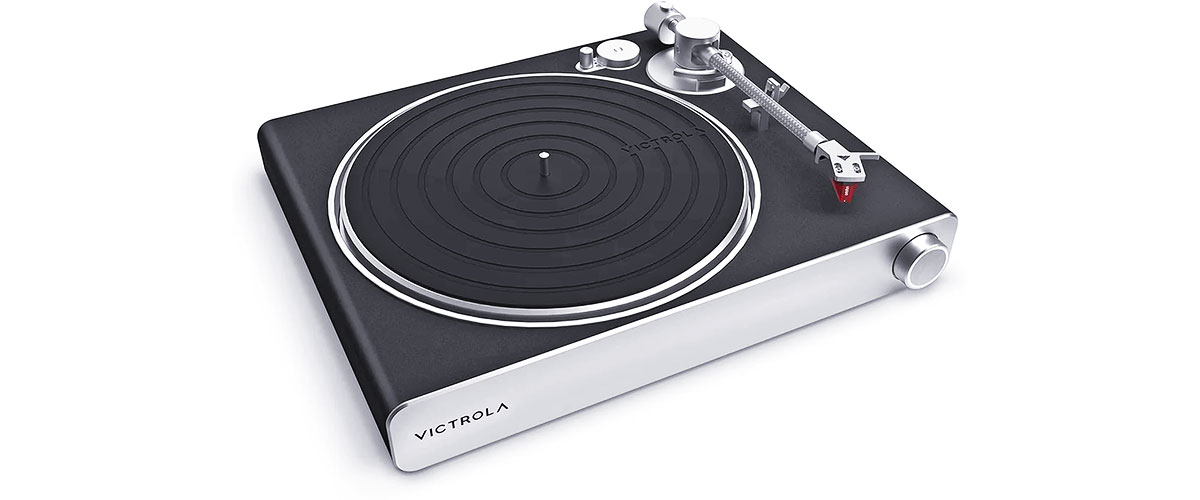
Victrola, a brand that carries a rich legacy from the days of vintage phonographs, brings an interesting fusion of old and new with Stream Carbon. At first glance, it evokes a sense of nostalgia, reminding us of the classic turntables that became icons decades ago. Yet, beneath its elegant exterior lies modern innovation.
Holding a record on this turntable, I was drawn to its sleek carbon fiber tonearm and thoughtfully crafted headshell. These aren’t just for show; they truly make a difference in the music’s sound. Paired with the Ortofon 2M Red cartridge, the audio clarity takes a leap forward, making each record spin a delightful experience.
One of the most compelling features of the Stream Carbon is its seamless integration with Sonos systems, allowing you to stream vinyl records throughout your home wirelessly. The setup process is made easy with the Victrola Stream App, which provides step-by-step instructions.
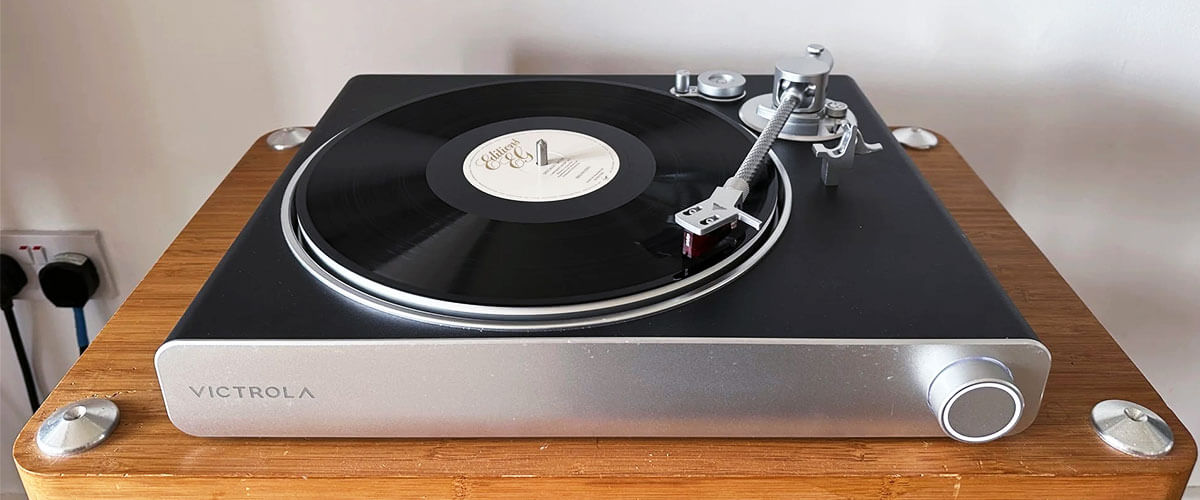
The audio quality of the Stream Carbon does not disappoint. Vintage vinyl records retain their characteristic warmth and texture, while contemporary records sound with a clarity that rivals digital formats. The ability to play across different Sonos zones simultaneously enhances the listening experience, creating a symphony of sound that fills every corner of your space.
Despite its many strengths, this unit is not without its limitations. The turntable’s wireless functionality is exclusive to Sonos systems, which could be a drawback if you have different audio setups. Additionally, the Wi-Fi connectivity can be unpredictable at times, though this can be mitigated by using a wired connection.
In summary, the Victrola Stream Carbon is a unique blend of classic vinyl charm and modern technological innovation. This record player offers a way to integrate your LP collection into a contemporary audio ecosystem, providing flexibility and high-quality sound reproduction.
Key specs
- Drive type: belt.
- Operation type: semi-automatic.
- Speeds, RPM: 33 1/3, 45.
- Phono Pre-Amp: yes.
- Bluetooth : no.
- USB: no.
- Aux in.: no.
Pros
- High-quality components.
- Multiple connectivity options – can connect to Sonos devices via Ethernet or RCA ports or wirelessly over Wi-Fi.
- User-friendly app.
- Combines a vintage aesthetic with modern technology.
Cons
- Spotty Wi-Fi experience.
- The turntable only works wirelessly with Sonos systems.
We are supported by our audience. When you purchase through links on our site, we may earn an affiliate commission at no extra cost to you.
Our newsletter
* We will never send you spam or share your email with third parties

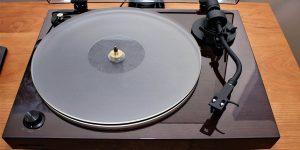
![Best Turntables Under $100 [Reviewed and Tested]](https://righttechadvice.com/wp-content/uploads/2023/09/best-turntable-under-100-300x150.jpg)
![Best Turntables Under $300 [Reviewed and Tested]](https://righttechadvice.com/wp-content/uploads/2023/10/best-turntable-under-300-review-300x150.jpg)
![Best Record Players Under $200 [Reviewed and Tested]](https://righttechadvice.com/wp-content/uploads/2023/10/best-turntable-under-200-300x150.jpg)
